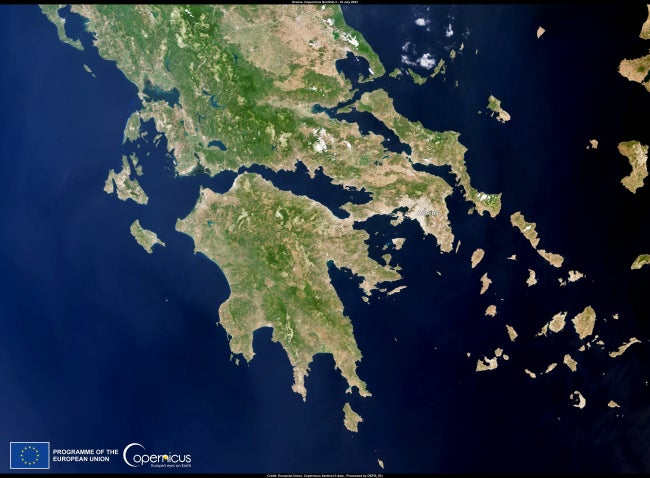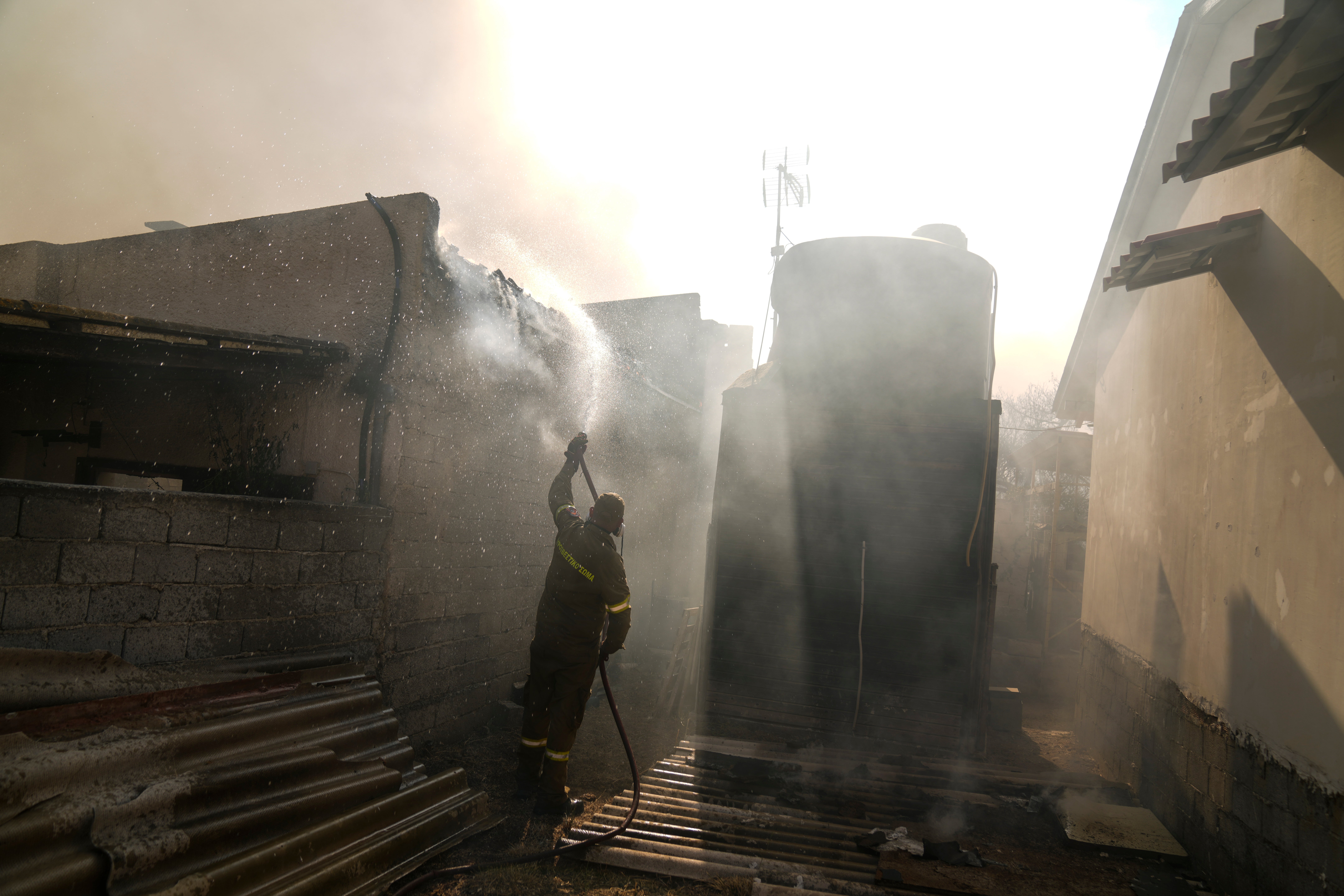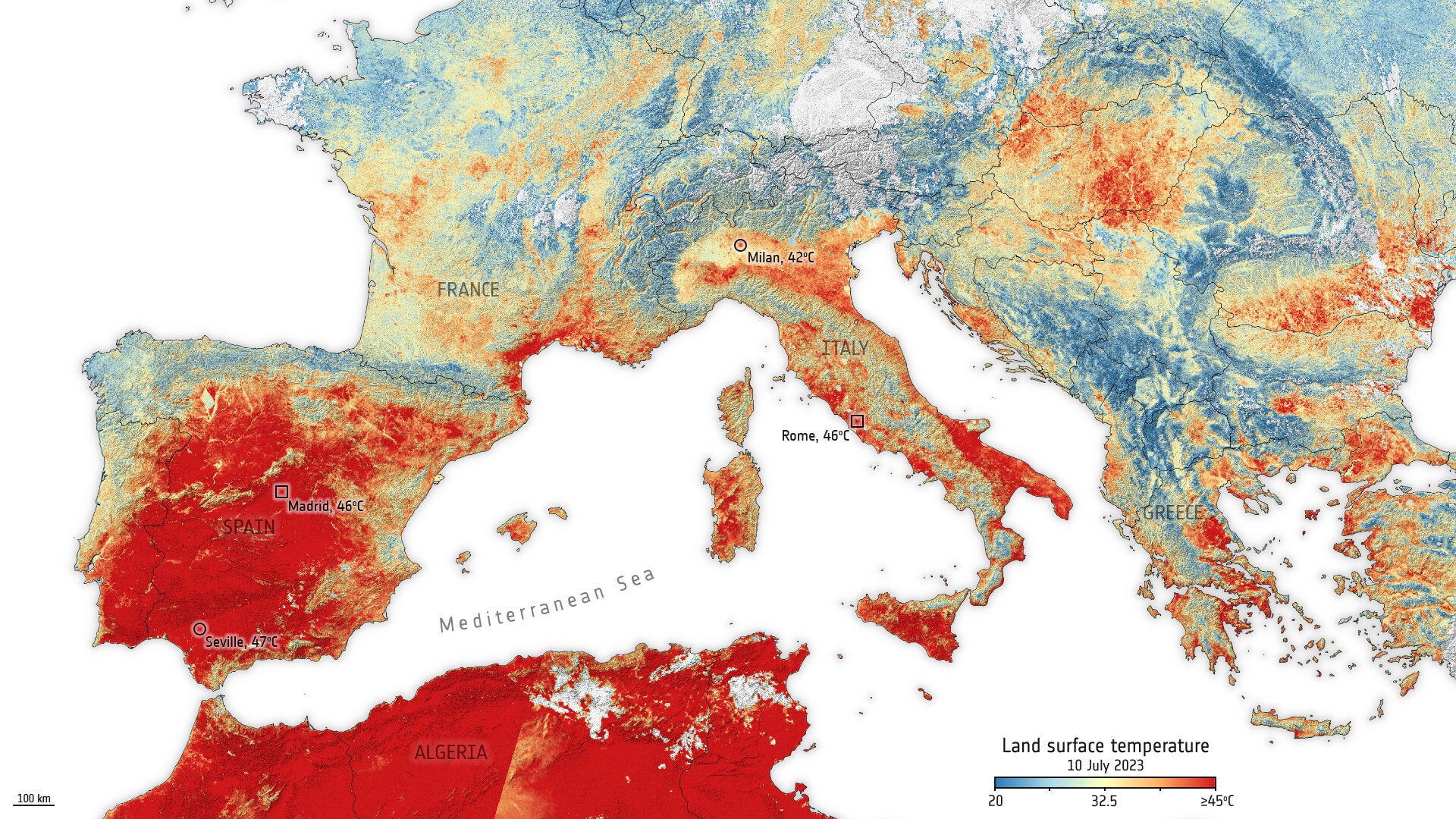Incredible satellite images reveal extent of heatwave across Europe
Global temperatures are soaring towards alarming highs with records expected to be broken
Satellite photos illustrating the ongoing exceptional heatwave in southern Europe have been released by the European Space Agency as global temperatures soar towards alarming highs with records expected to be broken.
One of the Copernicus Sentinel-3 satellite images captured on Sunday reveals a clear view of Greece without clouds, while another uses data from the mission’s radiometer instrument to show the land surface temperature across Europe and parts of northern Africa on the first day of the recent heatwaves.
The unrelenting heat began on 10 July with the record-breaking Cerberus anticyclone, which was felt most acutely in parts of the southeast and southwest of the continent, such as Greece, Italy, and Spain.

Then the anticyclone Charon, who in Greek mythology was the ferryman of the dead, advanced into the Mediterranean region from North Africa on Sunday, and it could soon lift temperatures well above 45C in the hottest areas.
Meteorologists predict that temperatures this week could surpass Europe’s current record of 48.8 degrees Celsius (119.84 Fahrenheit), set in Sicily in August 2021, while the World Meteorological Organization (WMO) has forecast the heatwave is likely to last into August.
The intensifying heatwave across southern Europe was mirrored around the world as millions of people in the US, Asia and Africa contended with extreme, record-breaking temperatures caused by a fossil-fuel-driven climate crisis.
UN scientists warn the Earth is entering “unchartered territory”, with all these events attributed to the worsening manmade climate crisis coupled with the impact of the El Nino phenomenon, which refers to the warming of Pacific waters.
While the extreme weather shows no signs of abating, below we take a look at the parts of Europe most severely affected by it in recent days, alongside the incredible satellite imagery showing the heatwave.
Greece
Residents and tourists at Mediterranean destinations have been told to stay indoors as a second heatwave in as many weeks hits the region - and as Greece, Spain and Switzerland battle wildfires.
In Greece, where a second heatwave is expected to hit on Thursday, three large wildfires burned outside Athens for a second day.
Thousands of people evacuated from coastal areas south of the capital returned to their homes on Tuesday when a fire finally receded after they spent the night on beaches, hotels and public facilities.
But wildfires continued to burn out of control to the north and west of Athens.
Authorities last week introduced changes in working hours and ordered afternoon closures of the Acropolis and other ancient sites to allow workers to cope with the high heat.
Meanwhile, volunteers have been handing out drinking water.
Temperatures as high as 44C are expected in parts of central and southern Greece by the end of the week.

Italy
Italy is bracing for its highest-ever temperature on Tuesday as Sardinia and Sicily have been forecast to reach 48C.
Tourists in Rome have been cooling themselves under giant fans set up outside the Colosseum and taking turns to drink from a fountain near the Spanish Steps.
Meanwhile, Red Cross teams have been checking on the elderly by phone.
The country’s health ministry on Monday issued red weather alerts - signaling a possible health threat for anyone exposed to the heat - for 20 of the 27 main Italian cities on Tuesday, from Bolzano in the north to Palermo in the south. The number is expected to rise to 23 on Wednesday.

Spain
Most of Spain is under alert for high to extreme heat, with forecasts calling for peak temperatures of 43C in areas along the Ebro River in the northeast and on the island of Mallorca.
Spain is also dealing with a prolonged drought that has increased concerns about the risk of wildfires.
Some 400 firefighters assisted by nine water-dumping aircraft laboured to extinguish a wildfire which burned for a fourth consecutive day on La Palma in Spain's Canary Islands and forced the evacuation of 4,000 people. Authorities said a perimeter has been established around the blaze but it is still active.
Volunteers have been reminding people to protect themselves from breathing in smoke from fires.

France
France's public health agency said the current stretch of hot weather would probably hospitalize or kill "many" people, as heat waves have done almost every summer since 2015.
As many as 61,000 people may have died in Europe during heatwaves last summer, with a repetition feared this season.
“My worry is really health - the health of vulnerable people who live just below the rooftops of houses that are not prepared for such high temperatures,” said Robert Vautard, a climate scientist and director of France’s Pierre-Simon Laplace Institute. “That could create a lot of deaths.”
Switzerland
In Switzerland, some 150 firefighters, police, troops and other emergency teams backed by helicopters fanned out on Tuesday to fight a wildfire that engulfed a mountainside in the southwestern Wallis region, evacuating residents of four villages and hamlets in the area.
"Heatwaves are really an invisible killer," Panu Saaristo, emergency health unit team leader for the International Federation of Red Cross and Red Crescent Societies, told a briefing in Geneva. "We are experiencing hotter and hotter temperatures for longer stretches of time every single summer here in Europe."
Join our commenting forum
Join thought-provoking conversations, follow other Independent readers and see their replies
Comments


Bookmark popover
Removed from bookmarks